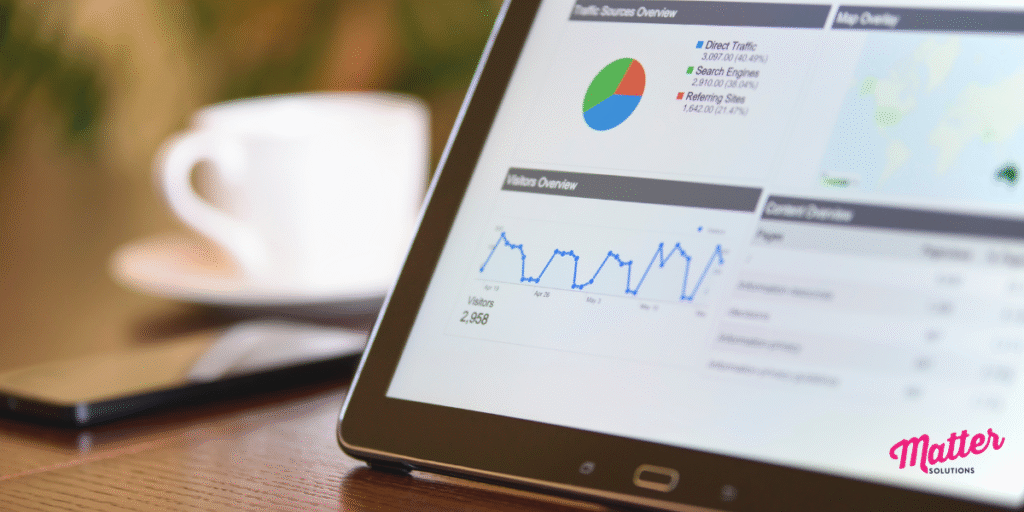You’re losing customers to competitors who show up first in local search results (and yes, we know that sinking feeling when competitors outrank you). Every day, potential customers in your area use Google to find local businesses like yours. But the problem is, they’re calling your competition instead.
And to be honest, it’s not because they have a prettier website or that they spend more on digital marketing. It’s just that they show up when local customers search for the services you offer. Matter Solutions works with Minnesota trade businesses on this exact challenge.
And this guide will show you exactly how to get started.
What Makes Local Search Different in Minnesota
Believe it or not, 46% of all Google searches have local intent, which means nearly half of everyone using search engines wants to find local businesses nearby.
The seasonal factor plays a huge role in local SEO strategy here. As Minnesota’s harsh winters drive more customers indoors, where they research companies through local search results before picking up the phone.
For example, when furnaces fail at 2 AM in January, homeowners aren’t randomly calling. They’re checking Google Business Profile listings, reading Google reviews, and comparing local rankings before they contact anyone.
Also, Twin Cities businesses face different local SEO competition than out-of-state companies. So, while Minneapolis and St. Paul have dozens of competitors fighting for the same local customers through digital marketing, smaller cities might only have three to five local companies competing.
What’s more, HVAC companies and other service businesses see massive search engine traffic spikes every January when heating systems break down during cold snaps. Local SEO helps these businesses capture more qualified leads exactly when potential customers need them most.
Now that you know why local SEO is different for Minnesota businesses, how do you get started? The short answer is your Google Business profile.
Your Google Business Profile is Your Digital Storefront
Did you know, 76% of people who search for something nearby visit a business within a day? That’s why optimising this free tool should be your first step in any local SEO strategy.

Once you nail these three areas, you’ll see more local customers finding your business through Google search results.
Complete Your Business Profile
Fill every section: hours, services, photos, attributes, and business description. Google ranks complete business profiles higher in local search results (because apparently Google loves a chatty business).
The numbers back this up: businesses with optimised Google Business Profile listings get 42% more direction requests and 35% more website clicks.
Drawing from our work with Minnesota trade businesses, complete profiles consistently outrank competitors by 3-5 positions. This on-page optimisation takes about an hour, but it can help your local SEO efforts for months.
Get More Google Reviews
Reviews have the potential to boost your local ranking and build trust with potential customers searching for your services. We recommend replying to feedback within 24-48 hours and asking for reviews immediately after finishing a job.
Also, make sure to thank positive reviews and address concerns professionally in negative ones.
Show Up in Google Maps
Getting into the top three business listings means more local customers see your contact information instantly when they search. Also, reviews and complete business profiles directly impact map pack rankings.
So, optimise your service area details and keep your Google Business Profile active with regular updates.
How to Build Your Local Citation Network
Citations are your business name, address, and phone number listed across different websites. Think of them as votes, i.e. the more consistent these are, the higher your local SEO ranking climbs in search results.
Major citation platforms include:
- Industry directories like HomeAdvisor and Angi help trades reach more local customers. Pick directories where your target audience actually searches for services.
- Local chambers and Minnesota business associations boost local search rankings since Google trusts these established community organisations.
- Apple Maps and Bing Places are also important. Keep in mind that not everyone uses Google to find local businesses in their area.
Quick tip: Make sure your business’s Name, Address, and Phone must match exactly everywhere. One wrong digit drops your local ranking by 5-10 positions.
We mentioned this because one of our clients, a St. Cloud HVAC company, fixed citations across 15 directories and quickly jumped from position 8 to position 2.
If you’re wondering if there’s any other way to target local clients, even more narrowly, we’ve got a few tips for you in the next section.
Target Local Customers with Location Content
Location-focused content helps you rank for searches in every suburb you serve. You might be wondering how to create this without sounding robotic or stuffing keywords everywhere. The answer is simpler than most digital marketing agencies make it sound.

Just create suburb-specific landing pages for each area, like Edina HVAC services, Minnetonka heating repair, or Bloomington plumbing. And answer actual questions your local customers might type into search engines.
Questions like “How much does furnace repair cost in Minnesota?” bring qualified leads because people need your services right now. It’s cause they’re past the research phase and ready to call someone.
As we’ve mentioned before, seasonal Minnesota content works for local SEO strategy, too. We recommend writing about spring storm damage or winter prep guides, and sharing project case studies with suburb names woven in naturally.
Here’s a helpful tip: Write for humans first, search engines second (most businesses skip this entirely, which is why it works). If you don’t include location terms in headers and opening paragraphs, Google won’t know which areas you serve.
Once this content goes live, you’ll see which pages drive more local customers to your website.
Now that you’ve got the tactics sorted, let’s see how to measure success.
Improve Your Local Search Results
This may come as a surprise, but about 78% of local mobile searches result in offline purchases. Why? Because people searching on phones are ready to buy services right now.
And if you don’t track the right metrics, you won’t know what brings customers through your door. But with hundreds of metrics piling up every day, which ones do you focus on?
- Google Business Profile views show how often you appear in local search results for your target keywords.
- Direction requests mean people are ready to visit your location. High-intent local customers have already decided to check you out.
- Phone calls from your profile are the highest-value leads. Someone calling from Google wants your services now.
- Website clicks measure engagement from your business listing. Once this happens, your site needs to convert these potential customers.
- Search queries report reveals which keywords trigger your business profiles in local rankings.
Through our practical work managing local campaigns, we tend to focus on calls and directions over vanity metrics like views.
Remember to access everything via your Google Business Profile dashboard and compare month-over-month to improve your local SEO strategy.
Ready to Compete in Local Search?
Local SEO competition in Minnesota keeps getting tougher each month. But here’s what you control: your Google Business Profile, consistent citations across business listings, location content, and review management through local SEO services.
Small, consistent SEO efforts compound over weeks. Just focus on the fundamentals, track your rankings, and watch your local customers grow month after month!
